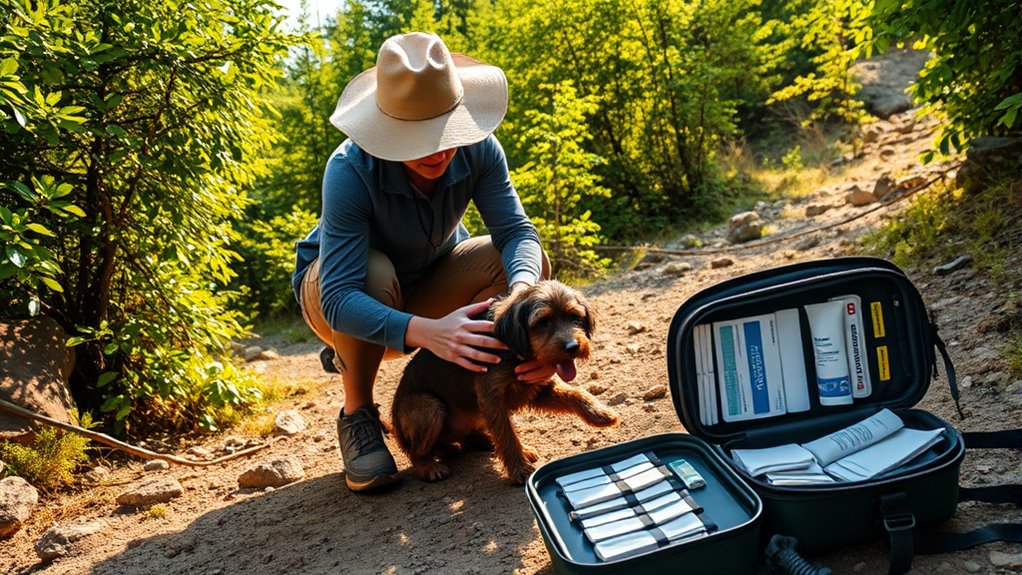When trail injuries occur, act quickly by evaluating your dog’s condition. Control bleeding with direct pressure, keep the dog calm, and immobilize broken limbs if necessary. Clean wounds gently with water and monitor breathing. Use visual signals or call for help if possible. Staying calm and focused is essential for effective response. Continuing with basic first aid skills will help you handle common injuries confidently and keep your dog safe until professional help arrives.
Key Takeaways
- Quickly assess injuries for bleeding, punctures, or swelling, and control bleeding with direct pressure and elevation.
- Keep the dog calm, immobilize broken limbs if necessary, and monitor vital signs until professional help is available.
- Clean wounds with water and mild antiseptics to reduce infection risk before veterinary care.
- Recognize signs of distress, such as difficulty breathing or unconsciousness, and respond with appropriate first aid measures.
- Use visual or audible signals to attract help if in remote areas, and stay calm to effectively manage the situation.

Have you ever wondered what to do if your dog suddenly gets hurt or shows signs of distress? It’s a situation no owner wants to face, but being prepared can make all the difference. When you’re out on a trail, injuries can happen unexpectedly, and quick, confident responses are essential. One of the first things to keep in mind is dog bite prevention. Dogs can become frightened or territorial, especially in unfamiliar surroundings, and they might bite if they feel threatened. To reduce the risk, always keep your dog on a leash, avoid sudden movements, and steer clear of unfamiliar or aggressive-looking animals. If you encounter other dogs, watch their body language carefully and maintain a safe distance. Teaching your dog proper social skills and recognizing warning signs can help prevent bites before they happen.
In the event of an injury, emergency signaling becomes indispensable. Clear, calm communication can draw help effectively. If you’re alone, use your phone to call for assistance, but also be prepared to signal for help visually. A whistle or loud call can alert others nearby, especially in remote areas where cell service might be unreliable. If your dog gets bitten, it’s imperative to assess the wound quickly—look for bleeding, punctures, or signs of infection. Apply direct pressure with a clean cloth to control bleeding, and keep your dog as still and calm as possible. Remember, even minor bites can become infected, so cleaning the wound with water and a mild antiseptic is a good step until you can get veterinary care. Additionally, knowing basic first aid procedures can greatly improve your response in emergency situations.
If your dog shows signs of distress—such as limping, bleeding, difficulty breathing, or unconsciousness—your response must be swift. Keep your dog calm and immobilize any broken limbs if you can do so safely. For bleeding, applying pressure and elevating the injured area can help slow blood loss. For breathing issues, ensure the airway isn’t obstructed and perform gentle mouth-to-snout resuscitation if needed. Always monitor your dog’s vital signs and try to keep them comfortable until professional help arrives. Remember, staying calm and focused can help your dog stay calmer as well.
Being prepared with knowledge about dog bite prevention and emergency signaling will serve you well in any outdoor adventure. Your quick, informed actions can prevent minor injuries from escalating and ensure your dog receives the care they need in those critical moments.
Frequently Asked Questions
When Should I Seek Veterinary Help Instead of First Aid?
You should seek veterinary help instead of relying on first aid if your dog shows signs of severe bleeding, difficulty breathing, or if the injury is deep or contaminated. Also, if you suspect a dog bite or need guidance on tick removal techniques, it’s best to consult a professional. Prompt veterinary attention guarantees proper treatment, preventing infection or complications, especially when immediate first aid isn’t enough to address the injury effectively.
How Can I Prevent Trail Injuries in Dogs?
To prevent trail injuries, you should focus on training techniques that build your dog’s confidence and responsiveness, making them less likely to panic or stumble. Additionally, consider dietary considerations that keep their joints healthy and energy levels stable. Regular vet check-ups help identify potential issues early. Always supervise your dog on trails, keep their paws protected, and carry a first aid kit to address minor injuries promptly.
What First Aid Supplies Are Essential for Hiking Trips?
For hiking trips, you need essential first aid supplies like antiseptic wipes, gauze, and adhesive tape. Don’t forget dog tick prevention tools such as tick removers and topical treatments. Carry paw pad care items like paw balm or booties to protect against rough terrain. These supplies help you respond quickly to injuries, keeping your dog safe and comfortable during outdoor adventures. Always be prepared for unexpected trail emergencies.
How Do I Recognize Signs of Shock in a Dog?
When recognizing signs of shock in a dog, look for rapid or weak pulse, pale or clammy gums, rapid breathing, and weakness or disorientation. Symptom identification is key to an effective emergency response. If you notice these signs, stay calm, keep your dog warm, and seek veterinary help immediately. Acting quickly can make a significant difference in your dog’s recovery, so remain alert and responsive to their changing condition.
What Should I Do if My Dog Is Choking?
Did you know that choking is a leading cause of trail emergencies in dogs? If your dog is choking, act fast: perform Doggie CPR if needed, and carefully check for obstacle hazards that might be blocking their airway. Gently open their mouth, remove any visible object, and if they can’t breathe, seek help immediately. Staying calm helps you respond effectively and keeps your dog safe.
Conclusion
Now that you know how to handle common trail injuries, you’re better prepared to act quickly and confidently. Remember, a stitch in time saves nine, so don’t delay when your furry friend needs help. Stay calm, assess the situation, and use your first-aid skills to keep your dog safe until you reach professional care. With a little know-how, you’ll be able to navigate unexpected setbacks and keep your adventure going strong.











